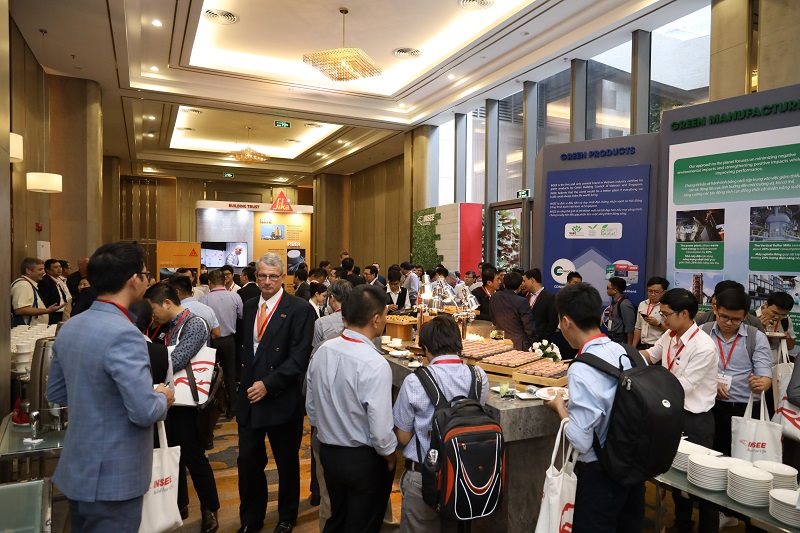Discussions about changes and contributions from enterprises active in the construction industry in the advent of new technology took center stage at Large Infrastructure Project Conference 2019 organized by INSEE Vietnam.

Megacities: challenges and potential
Material revolutions or smart construction solutions are altering what cities look like and speeding up urbanization in many countries, including Vietnam.
Growth has benefited residents but piled pressure on infrastructure, houses, services and the environment. This has become a problem at a time when the world is facing worsening climate change.
The United Nations (UN) selected October 31 as World Cities Day to encourage experience sharing and cooperation among countries in promoting success of urbanization and tackling challenges arising from the urbanization process. The theme of this year focuses on innovation to create a better life for future generations.
In Vietnam, a variety of forums and conferences to discuss urban planning and construction have been organized. Notably, the annual conference, Large Infrastructure Project Conference held by INSEE Vietnam, an affiliate of Jardines, in partnership with Sika and Doka, brings together industry leaders, experts and enterprises active in the construction industry.
Last year, the first edition of the conference looked into issues involving smart cities and the fourth industrial revolution, whereas the conference that took place on November 22 this year featured the theme “Rethinking Construction.”

“Our objective by organizing this event is to create a platform where Government authorities, construction industries, developers, designers contractors, suppliers can share new ideas and exchange on how to build a better place – on How to BUILD FOR LIFE.” Said Philippe Richart - Member of the Siam City Cement Company (SCCC) Ltd, Group Executive Committee, Thai Land & General Director of INSEE Vietnam.
“I think technology and knowledge sharing and cooperation when rethinking construction will benefit not only Vietnam, but also many countries in the world,” Baptiste Legeret, Commercial Director of INSEE Vietnam, also shared the Saigon Times Times on the sidelines of the event.
According to Standard Chartered Bank, Vietnam will need some US$605 billion to invest in infrastructure by 2040. Foreign investors are eyeing the Vietnamese market due to the country’s stable economic growth and its potential and priority for investment in traffic infrastructure, water and energy.
“The major challenge for emerging markets is to seek new funding solutions aside from traditional methods. It is necessary for relevant parties, including investors, authorities and residents, to join hands to offer financial support for infrastructure projects,” said Nirukt Sapru, CEO of Standard Chartered Bank Vietnam.
Promoting the value chain
Each year, the world spends up to US$10 trillion on high-rise buildings and urban infrastructure. Technologies for construction and materials have expedited urbanization and made the process more effective, and the potential of the technologies remains huge.
“The value chain of the construction industry currently holds great potential in improving output and productivity thanks to digitalization and new construction techniques,” said Philippe Richart.
Pham Van Bac, Director of Building Material Department - Ministry of Construction, said that in early 2000, Vietnam was depending on material imports, some building materials now meet the same standards as in developed countries or can even be exported.
New trends of the world construction industry have gained traction in Vietnam, especially eco-friendly buildings and materials. Some solutions to minimize environmental pollution and cut fuels have been applied in the country. INSEE facilities are using waste from other industries to produce input materials for production, Bac said.

Many new technologies that have helped the construction sector boom over the past few years were introduced at Large Infrastructure Project Conference 2019. For example, SIKA’s concrete-3D printing technology helps speed up the pace of construction and make it far easier for engineers and architects to design buildings. Also, DOKA Vietnam’s concrete mold technology and cement produced by INSEE help reduce carbon dioxide emissions.
“These technologies are available in other countries and can be applied in Vietnam, speeding up the construction process,” according to the representative of INSEE Vietnam.
“Digitalization allows us to do things better. It expands the limits of what is possible and doable at a given time. The builder who adapts to digitalization faster has a real competitive edge to build faster, safer, and cheaper,” said Maris Bataljevs, Project Manager & Global Expertise Center High Rise Strategic Business EAP of Doka GmbH.
The potential of computer technology in handling problems related to design and operation of a project was presented by Hoang Duy Kien, deputy director of ARUP Vietnam. Input information not only offers an overall look ahead of the execution of the project, but also provides the best solutions to the developer.
In Vietnam, some firms, including INSEE, SIKA and Doka, have greatly contributed to widening cities and developing infrastructure quickly over the past few years, but the potential of the market is still enormous. As such, these firms are unstoppable with reforms.
“We must weigh existing challenges on climate change, urbanization and greenhouse gas emissions; adjust construction methods to make the market more sustainable; and adapt to new technologies,” Legeret said.
Obviously, the innovation factor plays a key role in the process of developing infrastructure, but the goal contractors go toward is sustainability.
The representative of SIKA said that the construction industry consumes a significant amount of natural resources, energy and manpower. Innovation means limiting the use of materials and energy, and driving yields.
“This is the first step, and the next value is sustainability,” Mavrodin from SIKA Vietnam said.
The representative of SIKA said that sustainability is defined based on the lifespan of a building. “Among infrastructure projects, we always wish architectural works to be safe and long-lasting and to receive few maintenance and repair services. At the end of their lifespan, we can recycle and reuse the components of these old works,” Mavrodin said.
The firms, such as INSEE, SIKA and DOKA, are acting as major contributors to the development of value chains to make industries smart and sustainable.
“In partnership with relevant parties, including contractors, suppliers, architects, engineers and authorities, we must boost the innovation process for sustainable construction,” said Legeret.
Large Infrastructure Project Conference 2019 was organized by INSEE Vietnam, formerly Holcim Vietnam, an affiliate of Jardines, in partnership with SIKA, DOKA, Vietnam Institute of Building Materials, Vietnam Green Building Council, the British Business Association and the Hong Kong Business Association.
Under the theme “Rethinking Construction,” the second edition, which took place on November 22, introduced the latest innovations and technologies of leading global companies to overcome barriers to traditional construction methods, save resources and move toward sustainable development.
INSEE Vietnam also aimed to build a community of leading building material suppliers and construction companies, cooperate to develop infrastructure and construction as well as improve city planning while enhancing living standards.





















